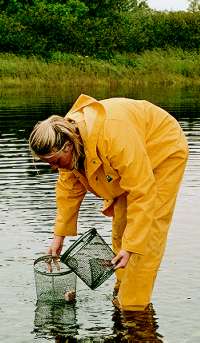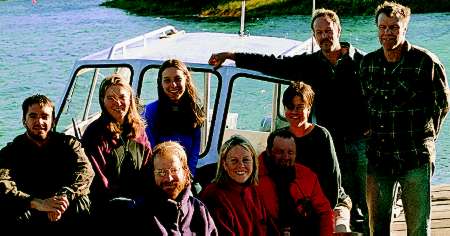Students added to that knowledge as they worked Hansen Creek near the Aleknagik Field Station. It is the kind of place most of us only read about: a creek thick with sockeye, more than 7,000 some days, in a body of water a little more than a mile long. The creek itself is only five feet wide and ranges in depth from 3 inches to a foot and a half. In the shallows salmon fight for mates and guard their nests, called "redds." Muddy outcrops are criss-crossed with bear tracks and littered with fresh and decaying salmon carcasses, many half stripped to the bone by bears.
Professor Quinn has a multi-year research program in the area comparing salmon populations for such things as differences in body size, body shape, age, physical habitat and bear predation.

Undergraduate Kirstin Holsman cleans a fish trap.
At each stream that is surveyed, students weigh fish, measure their length and the depth of their bodies, and gather information about average ages. They measure the streams to determine such things as how shallow it is at its mouth. Quinn says some streams have sand or gravel sills at the opening where the water may be only an inch deep. It's a barrier that strands a lot of fish, particularly the larger ones.
This simple observation begins the trade-offs that fish biologists consider when studying which fish spawn and which die before they get the chance to mate. For instance, large fish are better at fighting rivals but are also more likely to become stranded in the shallow water. Fish that are first to arrive may all be eaten by bears, but fish that arrive last may miss out on the best redd sites. Females prefer deep-bodied males (males can be between 6 to 12 inches from their fin to their bellies) but fish sticking higher out of the water are easier for bears to bite.
The observational work prompts a later class discussion. Students Tom Wadsworth and Chris Sarver make an interesting point. They'd always understood that males abandon the females after spawning. But in Hansen Creek it didn't look as if just the females guard their redds. Both students saw males sticking around even after they'd spawned and even though they could mate with other females. Greg Buck, a UW graduate student assisting with the class, confirms that sometimes large males have been known to help guard redds.

The UW's "Team Alaska" included six undergraduates for the first time. Front row seated, left to right: Chris Sarver, Kirstin Holsman, graduate student Greg Buck and Kai Chamberlain. Back row seated: Tom Wadsworth, Kristi Overberg and Mariah Meek. Standing: Professors Tom Quinn and Ray Hilborn.
Enthused by the field work—senior Kirstin Holsman said she learned more in the first two weeks than in a whole quarter of some classes back on campus—the students survey four more streams than planned. Most choose salmon behavior as the subject of their independent projects, one of the course requirements.
Kristi Overberg, for example, focuses on five creeks, comparing the shapes of fish and the physical variation of the streams to which they returned. Sarver conducts an experiment that shows 90 percent of fish return to the redds they established in a small pond if they are moved 200 feet downstream from the pond. Only 50 percent of the fish that are moved 200 feet upstream, however, make it back to their redds.
The independent project is one of the toughest course assignments. Six weeks sounds like plenty of time to choose a project and conduct experiments, however, the students are somewhat taken aback at having to select a topic almost from a dead start. "We arrived so close to the start of spawning at Aleknagik that those of us considering spawning research were told, 'Well, spawning starts in four days so you need to plan and do your pre-spawning work tomorrow,' " says Kai Chamberlain.
Chamberlain volunteers to help next summer's class before they leave and says she hopes students in coming years can build on the projects she and her classmates are doing. The other students concur quickly and enthusiastically.
| Read more about UW's innovative "Tools for Transformation" program. |
- Return to March 2000 Table of Contents
